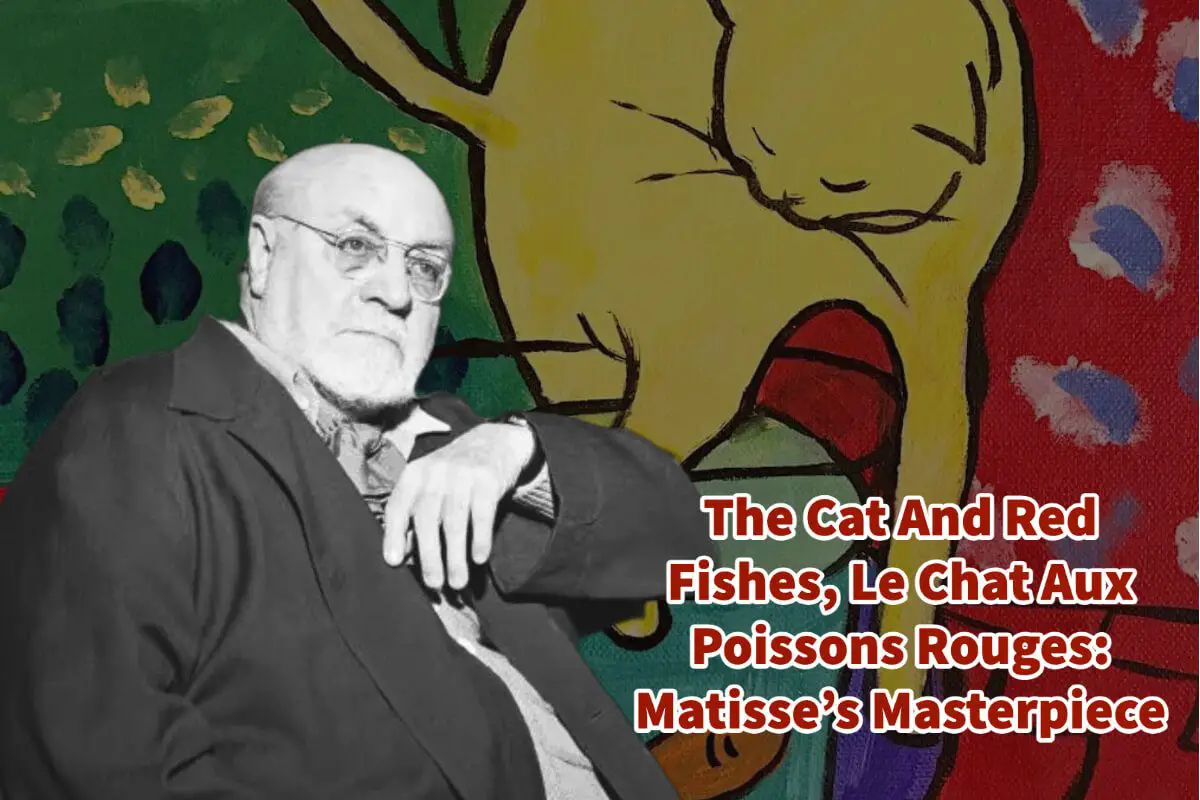The painting “Le Chat Aux Poissons Rouges,” or “The Cat With Red Fishes,” is a beautiful example of Henri Matisse’s mastery of color and form. Matisse’s canvas becomes a battleground for a silent tension between tranquility and chaos, as represented by the goldfish and the cat.
A profound love for pattern and ornament is evident in this piece. The Persian rug, the decorative wallpaper, the fishbowl, the cat’s fur – each component adds a distinct design element to the overall composition. The strength of Matisse’s Fauvist background is in full display through his use of bright, expressive colors. Contrasting the pale, striped cat against the intense reds, blues, and oranges is a testament to Matisse’s fearless approach to color and form.
Table of Contents
- About Henri Matisse And His Cat With Red Fishes, Le Chat Aux Poissons Rouges 1914
- Frequently Asked Questions
- Related Questions
About Henri Matisse And His Cat With Red Fishes, Le Chat Aux Poissons Rouges 1914
Henri Matisse, a titan of twentieth-century art, has left an indelible mark on the world of painting with his unique style and revolutionary approach to color and form. Known as a leading figure of the Fauvist movement,
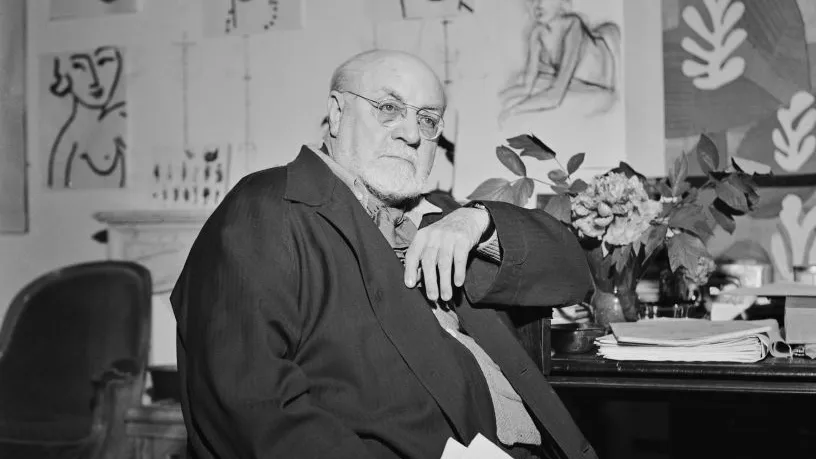
Matisse’s works are distinguished by their bold use of color and emotionally expressive aesthetics. One of his most captivating pieces, “Le Chat Aux Poissons Rouges” (The Cat with Red Fish), beautifully encapsulates his artistic philosophy.
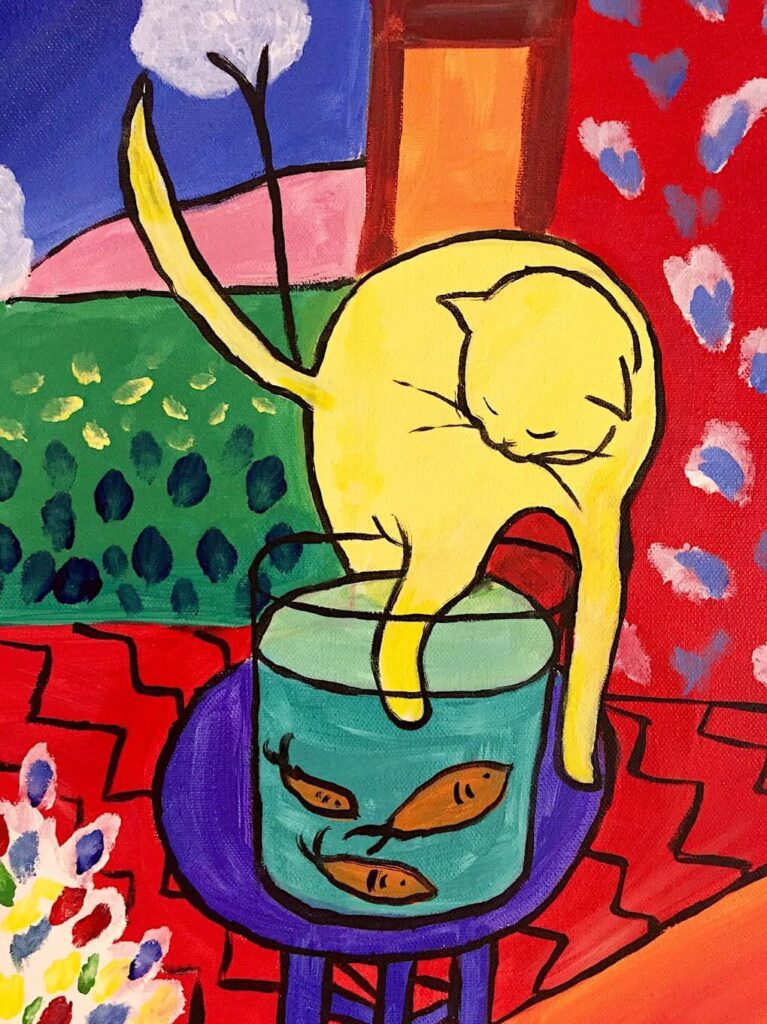
“Le Chat Aux Poissons Rouges” (The Cat With Red Fish), Vibrant Colors And Patterns
This painting, completed in 1914, depicts a striking scene: a cat perched on a table, leaning over a bowl of red goldfish. The interior has vibrant patterns and colors, highlighting Matisse’s decorative sensibility.
I love Matisse as an artist because he also considered the interior room design in his paintings. The oriental rug, the patterned wallpaper, the exuberant foliage of a plant, and a spread of fruit on the table — each element contributes to the overall harmony of the composition.
The way Matisse weaves color and pattern into his canvas shows his love for ornamentation and design. His daring use of vibrant and contrasting colors is a testament to his Fauvist influences, and his command over pattern and ornamentation suggests a solid connection to textiles and craftsmanship.
The Gold Fish Are The Painting’s Focal Point
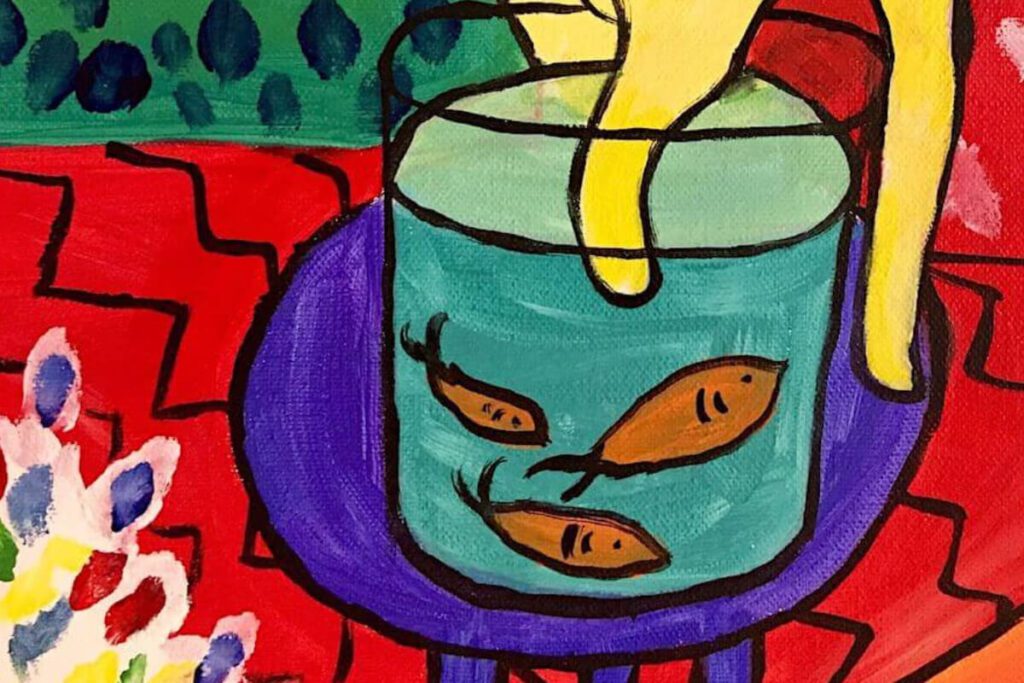
The goldfish, portrayed in vivid hues of orange and red, serves as the focal point of the painting. Situated in the center of the composition, the fishbowl exudes a quiet radiance.
It’s a world within a world, a vibrant cosmos captured within the glass confines of the bowl. Matisse’s choice of red color for the fish increases their visual potency, making them an irresistible attraction for both the curious cat and the viewer.
Henri Matisse Was Fascinated With GoldFish
The fishes hold a particular significance for Matisse, a fascination that was kindled during his travels in Morocco. He observed locals lost in the simple act of watching goldfish swim in their bowls.
The experience profoundly affected Matisse, inspiring him to represent the goldfish as tranquility and meditative peace symbols. In “Le Chat Aux Poissons Rouges,” the goldfish, blissfully encased in their glass world, reflect a serene existence that contrasts starkly with the external reality.
Contrasting this tranquility is the cat – a symbol of curiosity and disruption. The cat’s yellow fur starkly contrasts the interior’s luminous reds, blues, and oranges.
Poised on the table’s edge, the cat has a hand in the fish bowl, grabbing and playing with the fish. This impending action lends an air of tension to the painting, subtly interrupting the harmony of the scene.
The Cat Is A Metaphor Of Human Nature
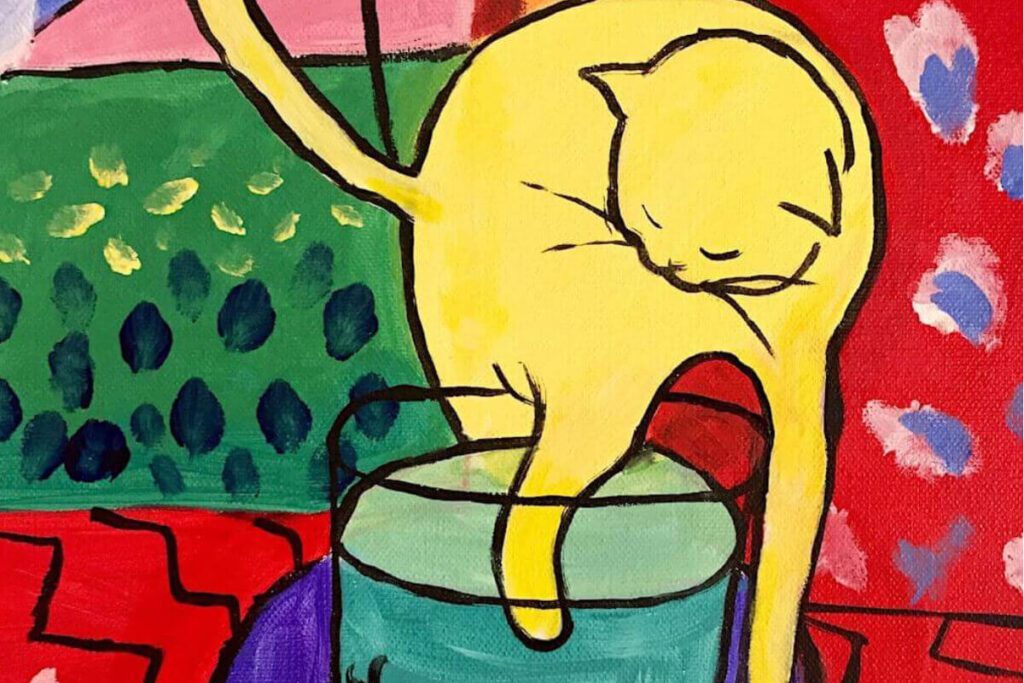
In this context, the cat can be interpreted as a metaphor for human nature – our curiosity, our yearning for the elusive, and our restless pursuit of the unknown. The tension between the cat and the fish portrays the quintessential human dichotomy: the peaceful world we yearn for and the chaotic realities we are bound by.
Matisse Was An Expert In Show Stillness And Calm
However, despite this underlying tension, the painting has a prevailing sense of stillness and calm. This is achieved by Matisse’s masterful use of form and composition.

The circular shapes of the fishbowl, the cat’s curved form, the arching leaves of the plant, and the round fruits on the table echo each other, creating a harmonious rhythm that weaves the elements together. This rhythmic interplay of forms and colors helps to balance the impending drama of the cat versus fish narrative, softening the contrast and imparting a sense of balance to the piece.
Matisse once shared this feeling about his paintings
“I don’t paint things. I only paint the difference between things.”
Henri Matisse
This philosophy is brilliantly illuminated in “Le Chat Aux Poissons Rouges.” The tranquility versus the chaos, the dreamer versus the realist, the static versus the dynamic – Matisse not only highlights these differences but also intertwines them to create a narrative that is at once compelling and reflective.
“Le Chat Aux Poissons Rouges” is more than just a striking tableau of color and form. It’s a silent commentary on the human condition, a narrative of contrasting worlds embodied in the goldfish’s tranquility and the cat’s curiosity.
The painting doesn’t just reveal Matisse’s mastery over color and pattern and underlines his deep understanding of life’s complexities and contradictions. Matisse’s genius lies in his ability to use his canvas as a stage where elements of life play out their roles, often in stark contrast yet in perfect harmony.
“Le Chat Aux Poissons Rouges” is a feast for the eyes, with its exuberant colors and decorative elements and an engaging narrative of an idyllic world and its potential disruptor. These qualities make Matisse one of the most celebrated artists of the 20th century, and “Le Chat Aux Poissons Rouges” is a compelling piece of art history.
Anita Louise Art is dedicated to art education, great artists, and inspiring others to find and create their art. We love art that uplifts and inspires. #ArtToMakeYouSmile! #ArtToMakeYouHappy!
If you want to see any of my art, you can find out more by clicking here. If you are interested in what inspires me and my paintings, you can discover more by clicking here.
We have a free newsletter and would love you to be part of our community; you can subscribe to the newsletter by clicking here. I would be happy to talk to you if you have any questions. You can reach me, Anita, by clicking here.
Subscribe to our Anita Louise Art YouTube Channel with great videos and information by clicking here.
Join us for our podcast “5 Minutes With Art.” Spend just 5 minutes a week with us to discover and learn about great art and artists. You can find out more about our podcast by clicking here.
Frequently Asked Questions
What is the significance of the title “Le Chat Aux Poissons Rouges”?
The title translates to “The Cat With Red Fishes.” It highlights the key elements of the painting – the cat and the red goldfish in the bowl. The interaction between these two subjects is central to the artwork.
How does Matisse convey a sense of tension in the painting?
Matisse creates tension through the juxtaposition of the calm goldfish and the poised cat. The silent interaction between the two species captures a delicate balance between tranquility and potential chaos.
What is the role of pattern and ornamentation in the artwork?
Pattern and ornamentation are integral to Matisse’s aesthetic in this piece. The Persian rug, decorative wallpaper, fishbowl, and cat’s fur contribute to the overall design, showcasing Matisse’s deep appreciation for intricate details.
How does Matisse demonstrate his Fauvist background in this painting?
Matisse’s Fauvist roots are evident in the bold and expressive use of color. The vibrant reds, blues, and oranges create a visually striking contrast, emphasizing his fearless approach to color that is characteristic of the Fauvist movement.
What is the significance of the Persian rug in the composition?
The Persian rug adds an additional layer of complexity to the composition, contributing to the overall visual richness. Its intricate patterns and warm tones enhance the setting, creating a harmonious backdrop for the cat and the goldfish.
How does Matisse use color to convey emotion in the painting?
Matisse employs a vibrant color palette to evoke emotion. The contrasting colors enhance the visual impact and contribute to the overall atmosphere of the painting, capturing the viewer’s attention and eliciting a range of feelings.
What is the symbolism behind the goldfish and the cat in Matisse’s work?
The goldfish and the cat symbolize a duality of elements. The goldfish may represent tranquility and fragility, while the cat embodies potential chaos or playfulness. The interaction between these symbols adds depth and narrative to the artwork.
How does Matisse use composition to guide the viewer’s attention?
Matisse strategically places the cat and the fishbowl in the center of the composition, drawing the viewer’s focus to the heart of the painting. The arrangement of elements and the use of negative space contribute to a balanced and captivating composition.
What is the historical context of “Le Chat Aux Poissons Rouges”?
Created in the early 20th century, the painting reflects the Fauvist movement’s departure from traditional artistic conventions. Matisse’s work during this period challenged academic norms, embracing bold colors and unconventional forms.
How did Matisse’s fearless approach influence the art world?
Matisse’s fearless approach to color and form had a profound impact on the art world. His contributions to Fauvism and modern art paved the way for future artists to explore new possibilities in self-expression, challenging established norms and traditions.
Related Questions
What Is Expressionism In Art? Definition & Characteristics
Expressionism is characterized by intense and subjective portrayals of the artist’s emotions; expressionism is a captivating art movement that emerged in the early twentieth century and has left an indelible mark on the art world. While the term “expressionist” can be applied to artworks from any era, it is primarily associated with the art of the twentieth century, starting with artists like Vincent Van Gogh and encompassing various renowned figures such as Edvard Munch, Henri Matisse, and Pablo Picasso.
By clicking here, you can learn more by reading What Is Expressionism In Art? Definition & Characteristics.
About Homage To Matisse (1954) By Mark Rothko
One painting Mark Rothko painted in 1954 is called Homage To Matisse. This painting is labeled differently than his other paintings, which are usually labeled with numbers and colors. But this painting was a personal tribute from Mark Rothko to the great French artist Henry Matisse and his influence on him and his artwork.
You can learn more by reading the blog About Homage To Matisse (1954) By Mark Rothko by clicking here.
20 Of The Most Beautiful Paintings Of Women Ever Created
The portrayal of women has long been a captivating and cherished subject in the annals of art history. From the hands of renowned male painters to the brushstrokes of influential female artists, the depiction of women has yielded a rich tapestry of remarkable and celebrated works of art.
By clicking here, you can discover more by reading 20 Of The Most Beautiful Paintings Of Women Ever Created.

